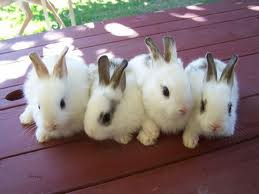A guide to baby rabbits

This page is all about baby rabbits. If you are buying, or thinking of buying, a rabbit and want to find out how to care for, and what to feed a young rabbit, then please go to Buying a Rabbit
The breeding season for most rabbits lasts 9 months with the average size of a litter usually between 4 to 12 babies (kits), but this does vary. Larger breeds of rabbits can have the larger litters.
Babies are born furless with their eyes closed.
A kit can be weaned (taken away from mother's milk and introduced to solid foods) at about 4 to 5 weeks.
A young doe is able to breed at about 5 or 6 months and a young buck at around 6 or 7 months.
Due to the very nutritious nature of a mother rabbit's milk, babies (kits) only need to be nursed for a few minutes, once or twice a day.
In the nest, adults have a scent and babies do not. For this reason a wild mother rabbit knows that staying with her offspring will attract a predator's attention.
Domestic rabbits also instinctively sense this, so the same applies.
In the wild the young rabbits spend their first weeks underground in a part of the burrow, separated from the rest of the warren, where only the mother visits, for suckling.
However, it is not uncommon to find a nest of wild rabbits in the countryside or in a rural garden.

A wild rabbit nest discovered in a rural garden
Most mothers will not hop in and out of the nest, checking on the offspring. This is normal behaviour. The mother does, however, watch from a close distance.
For both of the above reasons, it can be misunderstood when a mother is not often seen with her babies, that the babies are not being fed or cared for, which as a rule, is not the case.
A mother rabbit may only feed her offspring when she feels safe, usually just before dawn or just after dusk.
With domestic rabbits, humans or a lot of disturbance can cause the mother rabbit to become too stressed to feed her offspring.
Around 10 to 11 days after the birth, the baby rabbit's eyes open and they begin eating the mother's cecotropes around this period.
Cecotropes provide the baby with essential nutrients and later inoculate the hindgut with the essential flora (microorganisms that live in the digestive tract that perform a host of useful functions) needed to metabolize a diet that's changing from milk to solid foods.
Although born furless, they form a soft baby coat of hair within a few days and around 5 to 6 weeks after the birth, the soft baby coat is replaced with a pre-adult coat.
At about 6 to 8 months of age, this intermediate coat is replaced by the final adult coat, which is shed twice a year thereafter.
As baby rabbits begin to wean at around 4 to 5 weeks, they lose the support of their mother's milk and often many babies will do fine up to this stage.
However, it is from this point that there can be gastronomic problems, particularly due to lack of fibre. A lack of fibre slows down the gut motility, therefore allowing an environment for toxins to grow.
It is essential that domestic rabbits are
neutered (bucks) or spayed (does). Males (bucks) should be neutered as soon as their testicles drop and females (does) after about 4 months, but before a year.
Neutering/spaying will make young rabbits much more friendly and affable. They will live longer and make better companions to both humans and to other rabbits.
A rabbit mother's milk is very rich; one of the richest in the animal world and you cannot keep a baby rabbit alive on cow's milk, human baby milk or puppy/kitten milk.
Baby rabbits are born completely helpless apart from the instinctive ability to suckle. They will sense when their mother is around and hitch onto a teat.
If the mother is undisturbed then she will care for her offspring excellently. She will however, resent any interference of any type and will become anxious.
If the mother, or her babies, are interfered with the mother may disown or kill the babies. This is not uncommon.
There are a high proportion of mothers that either abandon or kill their complete first litter. Having said that, the mother then goes on to have successful following litters.
In captivity it can be three weeks before babies will voluntarily come out from their nest, in the mother's sleeping compartment.
At this stage they will have a full coat of fur, the eyes will be open and they will nibble solid foods, such as hay or tender greens.
Their main nourishment remains their mother's milk, and suckling will continue for six to eight weeks.
At this stage, 8 weeks, they are the perfect miniature version of a fully grown rabbit; they are very cute and delightful. Between now and ten weeks they quickly become tame and this is the best time to buy.
Leave ' Baby rabbits ' page and return to ' Rabbit Matters ' home pageThis charming online jigsaw puzzle shop now also has rabbit, cat & dog puzzles.
Friendly, excellent customer service with speedy delivery.
Click picture for more information or click puzzlemoments.co.uk to go direct to the store
Traditional, New & Interesting jigsaw puzzles for all puzzle lovers, or as an ideal gift for a loved one, family or friend !
